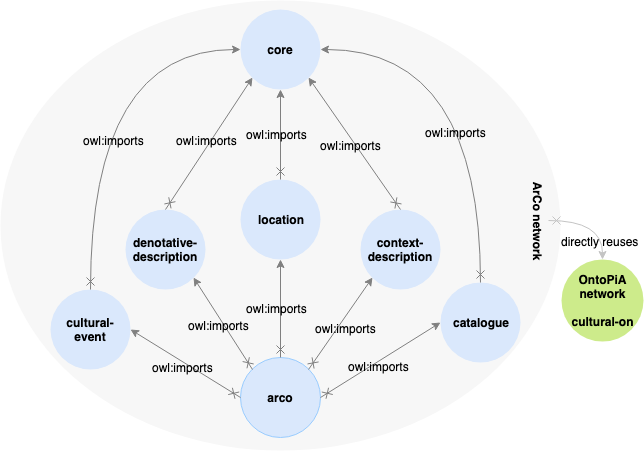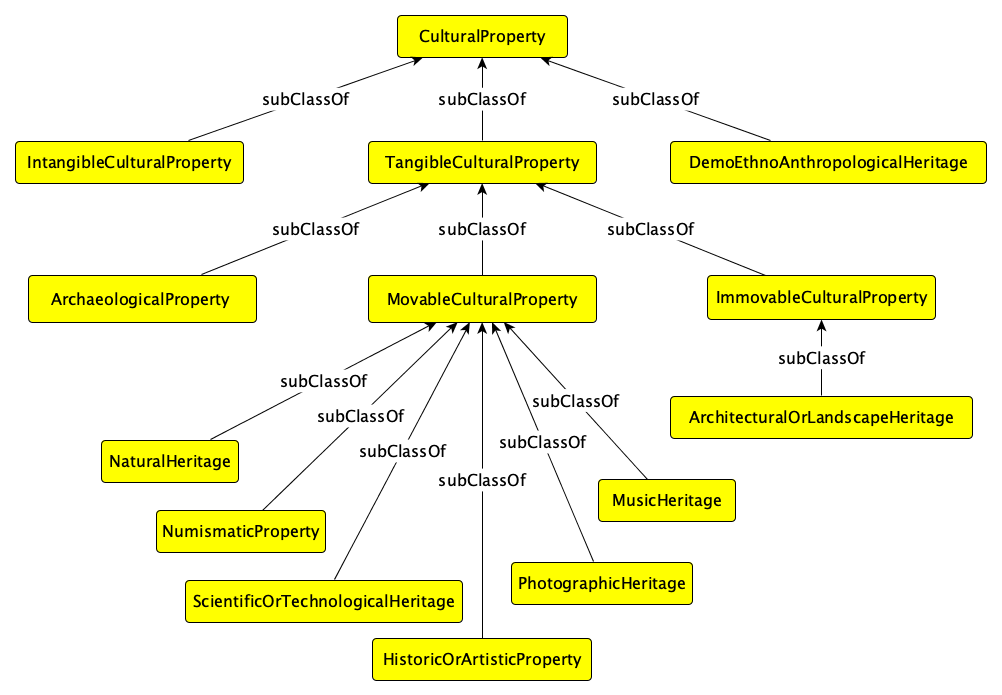ArCo Modules v2.0
In this section, all the main conceptual frameworks are briefly
illustrated with example diagrams of the v2.0 of the ArCo network. For
detailed descriptions, please refer to the "Ontologies" section on the
main page. Both the modeling choices and the vocabulary should be
considered stable.
For complete documentation on patterns, modeling, and testing of the
ontology network, please see the repository on
GitHub.
ArCo Module (arco:)
This module represents the entire ArCo network that imports all other
modules. It also models the information considered central in the
domain of cultural properties. The first diagram illustrates the
hierarchy of cultural assets: the central class arco:CulturalProperty
is represented as a partition between arco:IntangibleCulturalProperty
and arco:TangibleCulturalProperty. Intangible assets can further be
arco:MovableCulturalProperty and arco:ImmovableCulturalProperty. More
specific types of cultural assets are distributed across multiple
levels within this hierarchy.
Core Module (core:)
This module models the information considered top-level (e.g., the
relationship between a whole and its parts, between an entity and its
characteristics, between an entity and a generic location, etc.). It
is imported by all other modules in the network.
The following diagrams represent the most representative patterns and
models of this module.
"
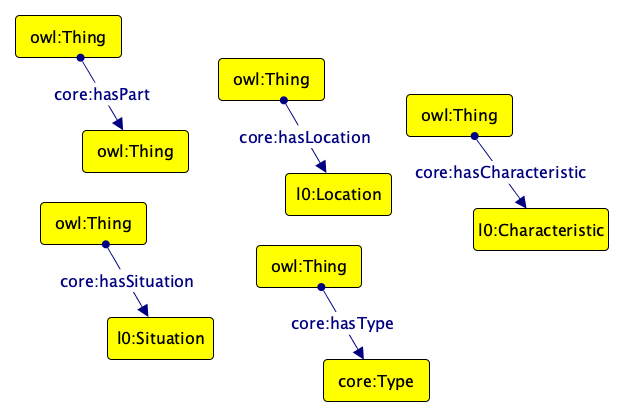
Agent Role
This pattern represents an agent (person, organization, etc.) and
the role they play.
For further documentation on the pattern, click
here.
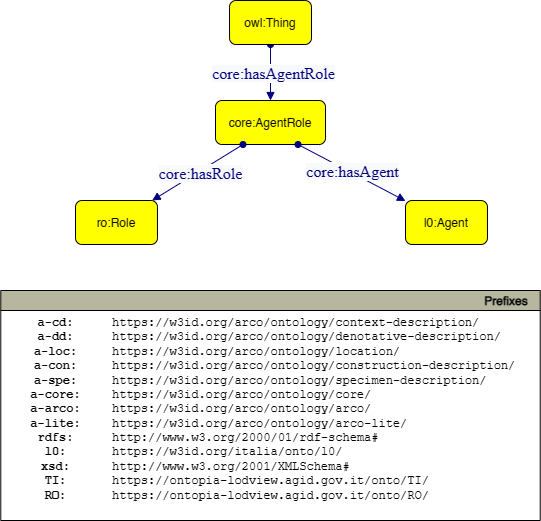
Classification In Time
This pattern represents the classification of an entity in the
temporal dimension. The pattern combines information about when the
classification was made, the reference system used, the actual
classifying concept, and the agent who performed it.
For further documentation on the pattern, click
here.
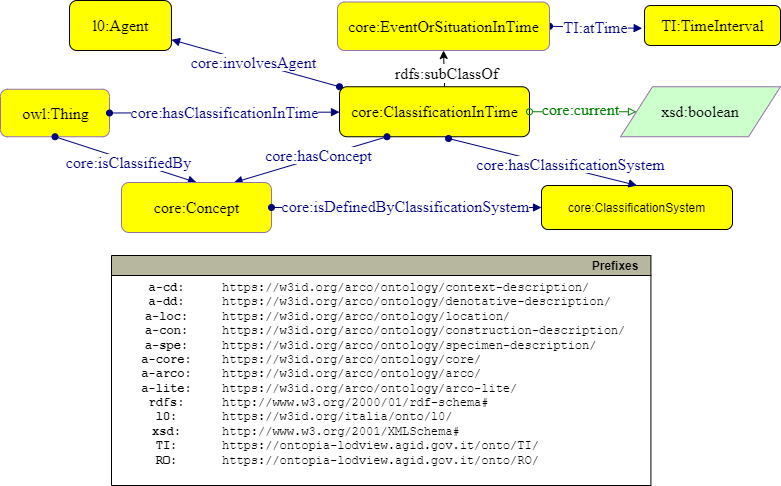
Identifier
This pattern represents an identifier given to an entity, linked to
the organization that issued it and the type of identifier described
(national, unique, local, etc.).
For further documentation on the pattern, click
here.
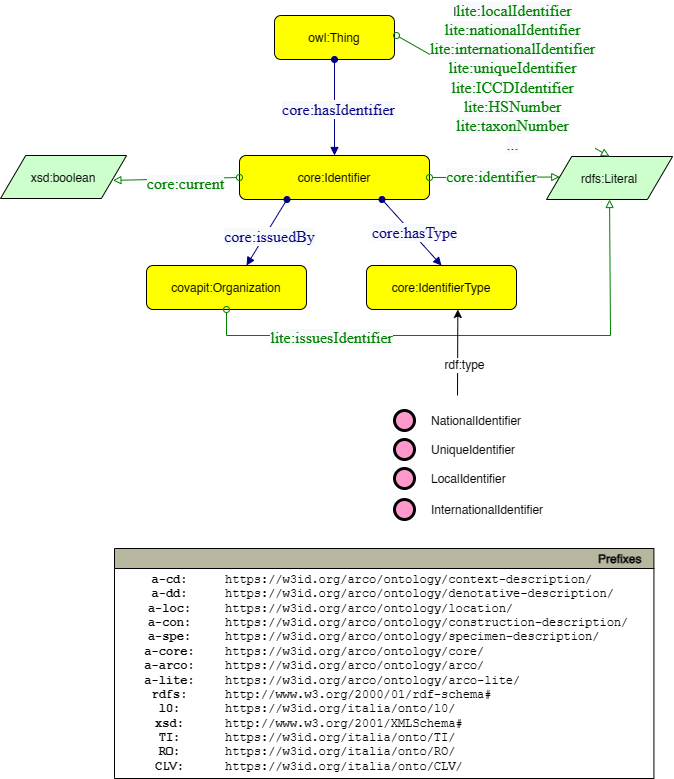
Classification System
This pattern represents the classification system used to define an
entity and is connected to the classifying concept, any associated
Classifications in Time, and the agent author of the system.
For further documentation on the pattern, click
here.
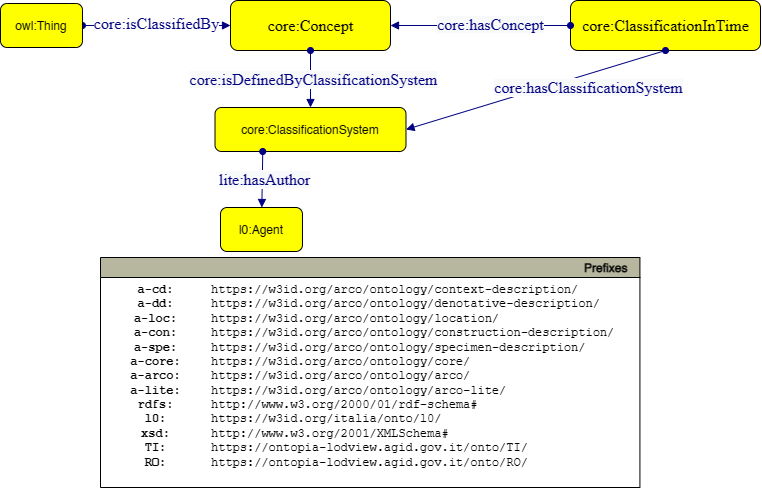
Taxon
This pattern represents the taxonomic category that classifies or
identifies a property or sample. It is connected to the
classification system used, the associated identifier, the author of
the Taxon, and the temporal indication.
For further documentation on the pattern, click
here.
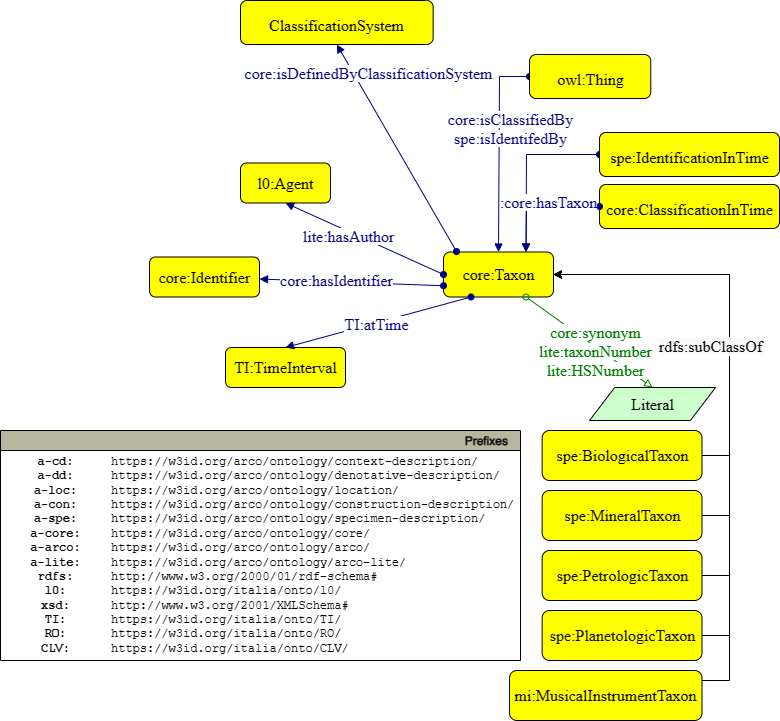
Denotative Description Module (a-dd:)
This module (denotation is understood as the act of indicating
something through external signs) models information related to the
cultural asset itself, observed/observable during the cataloging
process, and measurable according to a reference system. The following
diagrams represent the most representative patterns and models of this
module.
Affixed Element
This pattern represents elements affixed to a cultural asset (e.g.,
coats of arms, emblems, inscriptions, labels, etc.). The element is
linked to the described element type, its technical states (material
and manufacturing technique), measurements, the possible support it
is on, the type of writing and characters used, the language used,
its graphic system, the circumstances that led to the creation of
the element, its author, and even the recipient, if available.
For further documentation on the pattern, click
here.
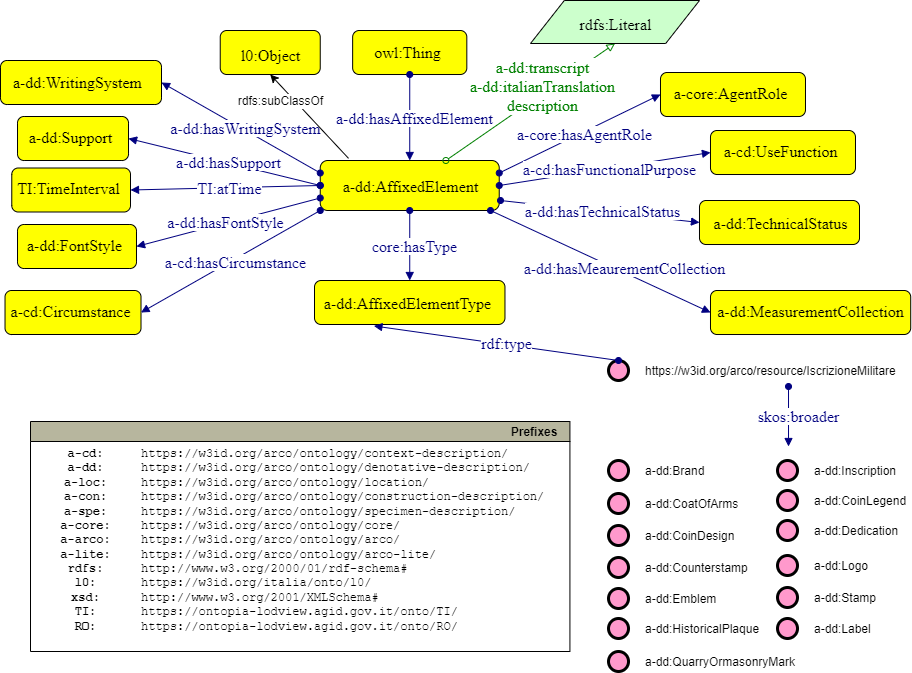
Conservation Status
This pattern represents the preservation status of an asset. It is
linked to the type of preservation status (excellent, good, fair,
etc.), the preservation method, any proposed restoration
interventions, and the readability of the information (complete,
good, etc).
For further documentation on the pattern, click
here.
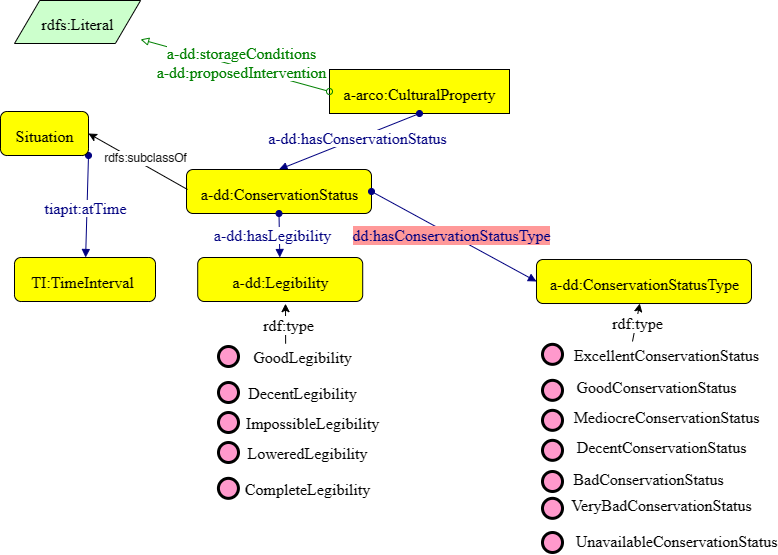
Cultural Property Type
This pattern represents the type of cultural entity being described,
along with its definition and specification.
For further documentation on the pattern, click
here.
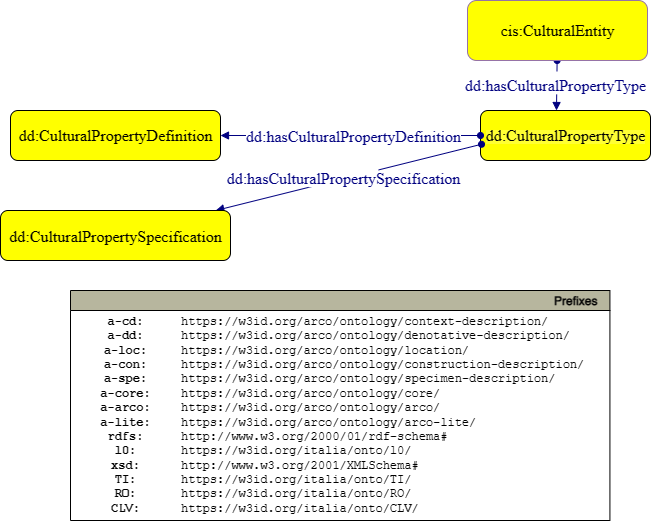
Measurement Collection
This pattern represents the collection of measurements describing an
asset. The collection is linked to individual measurements,
specifying the type of measurement being described (height, width,
duration, area, etc.), the unit of measurement, and the value.
For further documentation on the pattern, click
here.
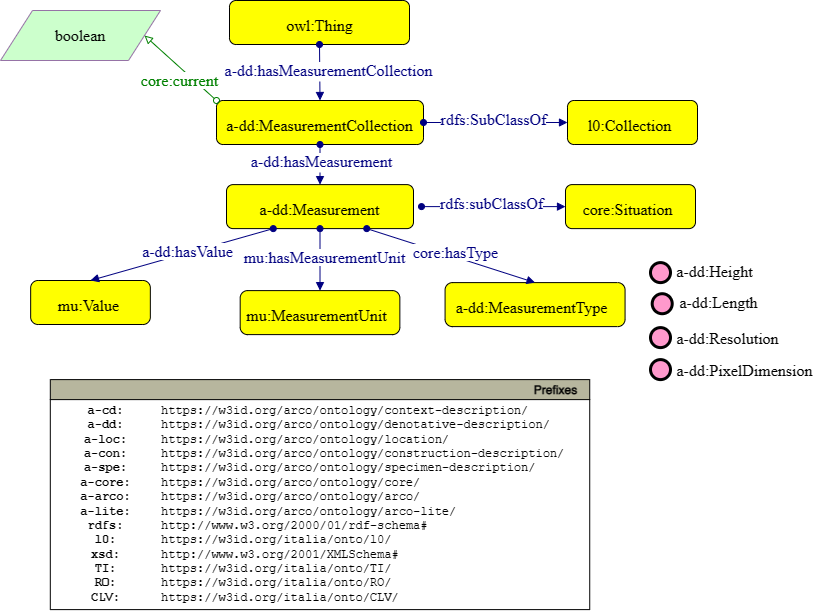
Technical Status
This pattern represents the technical status associated with a
cultural entity and describes its specific characteristics, such as
the material it is made of or the constitutive technique. It is
associated with all the technical characteristics of the asset
(e.g., marble), to which the respective technical concepts defining
them are connected (e.g., material).
For further documentation on the pattern, click
here.
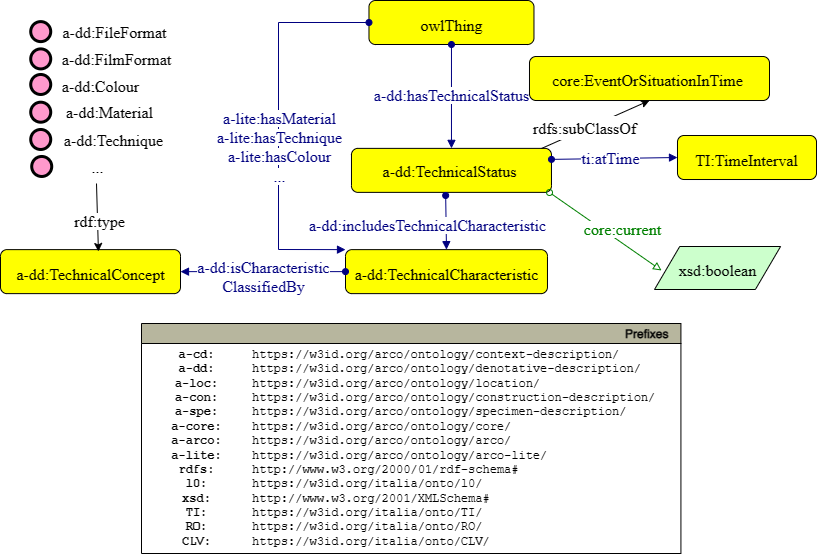
Module: Context Description (a-cd:)
This module models information concerning the context, broadly
defined, in which the cultural asset is situated throughout its
history. It encompasses attributes that are not quantifiable,
associated with the asset.
The following diagrams illustrate the most representative patterns and
models within this module.
Acquisition
The pattern represents the acquisition situation of an object. It
connects the involved agents with their roles, as buyers and
sellers, the type of acquisition method (e.g., purchase,
confiscation, transfer), the location, and the temporal reference of
the event.
For additional documentation on the pattern, click
here.
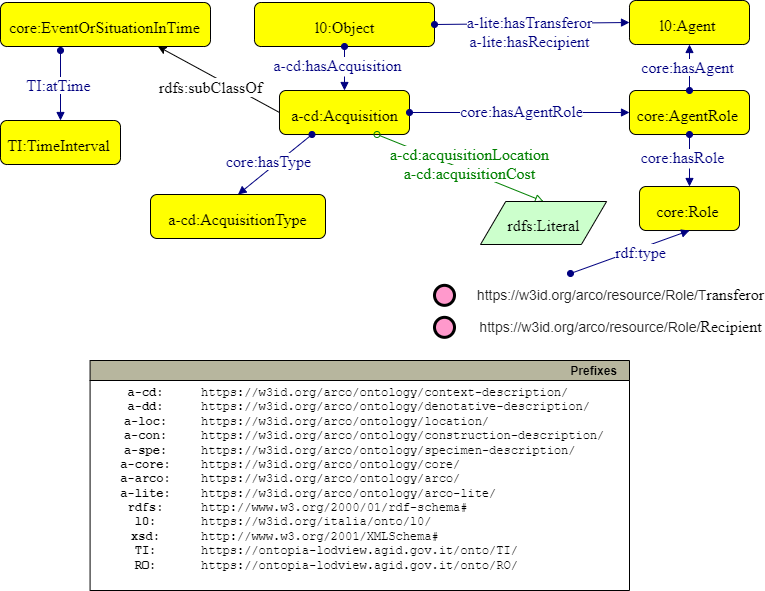
Age
The pattern represents the age of an entity. It links to the
numerical age value, the type of age being described (e.g., age at
the time of cataloging, age at the time of death, geological age),
and the source of information.
For additional documentation on the pattern, click
here.
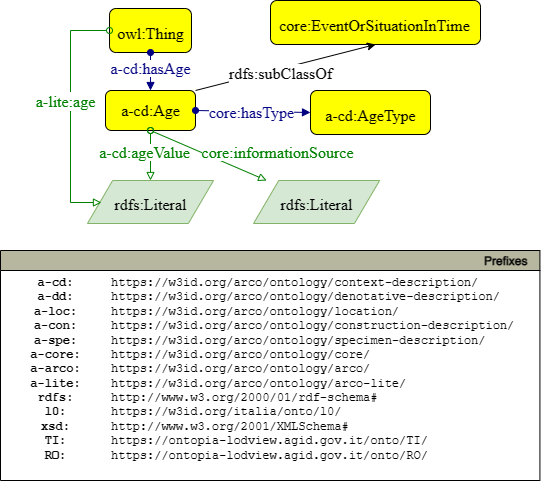
Collection Membership
The pattern represents the object's membership in a collection. It
connects the object in question, its position within the collection,
the collection it belongs to, the entry date, and optionally, the
exit date from the collection. The collector is also associated with
the collection.
For additional documentation on the pattern, click
here.
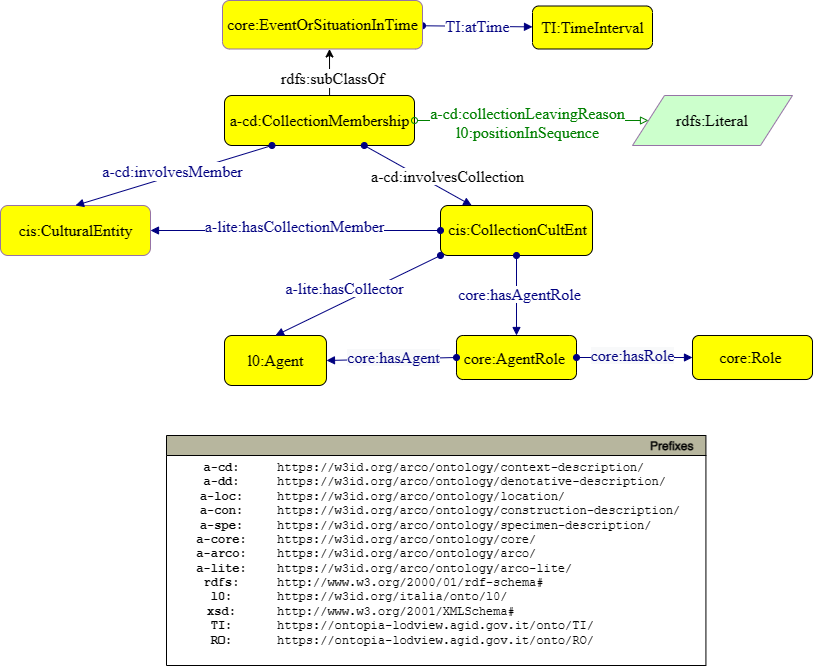
Commission
The pattern represents the commissioning situation of a cultural
asset. It links to the commissioning agent and sponsor, the temporal
reference of the event, and the circumstances in which the asset was
commissioned.
For additional documentation on the pattern, click
here.
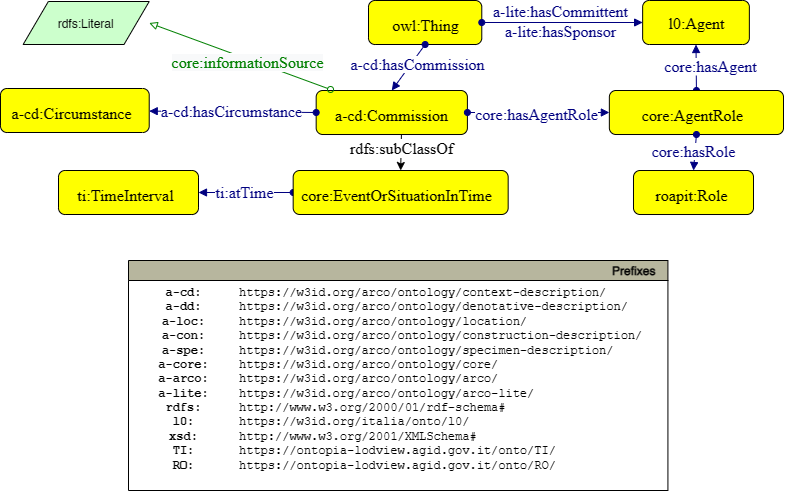
Copyright
The pattern represents the copyright and copyright holder of an
object. The copyright is linked to the rights holder, their
expiration date, and ownership status (active or expired).
For additional documentation on the pattern, click
here.
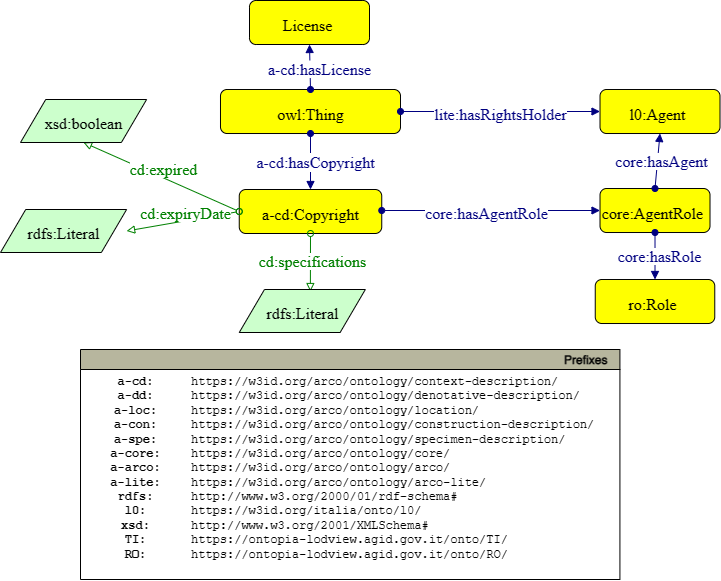
Dating
The pattern represents the chronological history of a cultural
asset. It is associated with the event, its temporal reference, the
type of chronology (preferred, alternative, obsolete, etc.), and the
source of the information.
For additional documentation on the pattern, click
here.
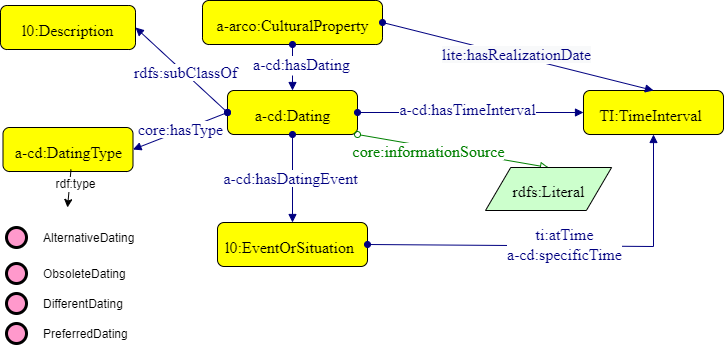
Designation in Time
The pattern represents the naming of an asset over time. It is
linked to the actual name, the type of name used (dialectal,
historical, alternative, etc.), the temporal and current validity
indications.
For additional documentation on the pattern, click
here.
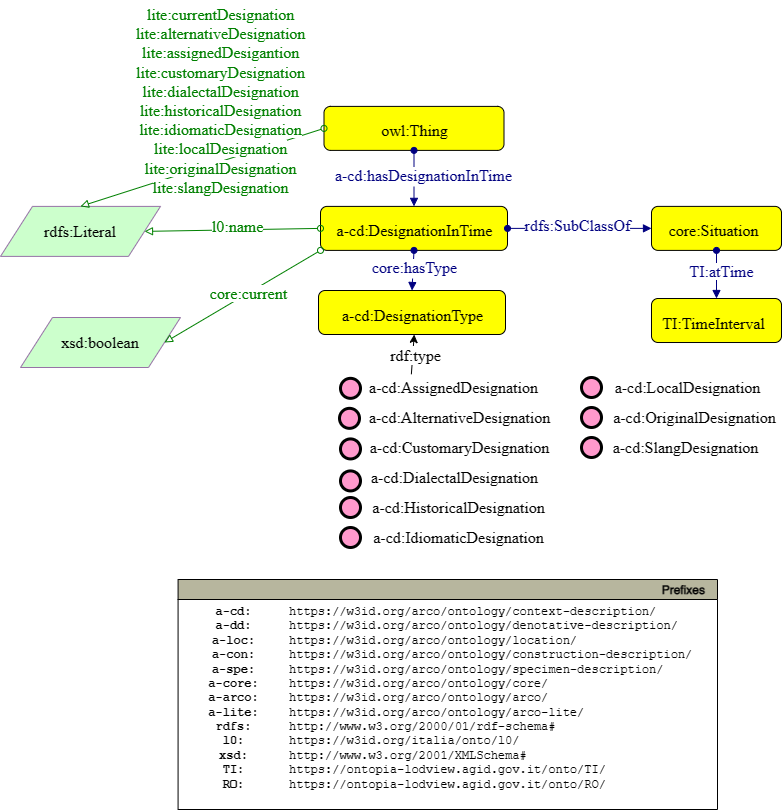
Documentation
The pattern represents the documentation of a cultural asset. It is
linked to the author and owner, the type of document, the document
format, associated rights (copyright and licenses), identifier,
title, and location.
For additional documentation on the pattern, click
here.
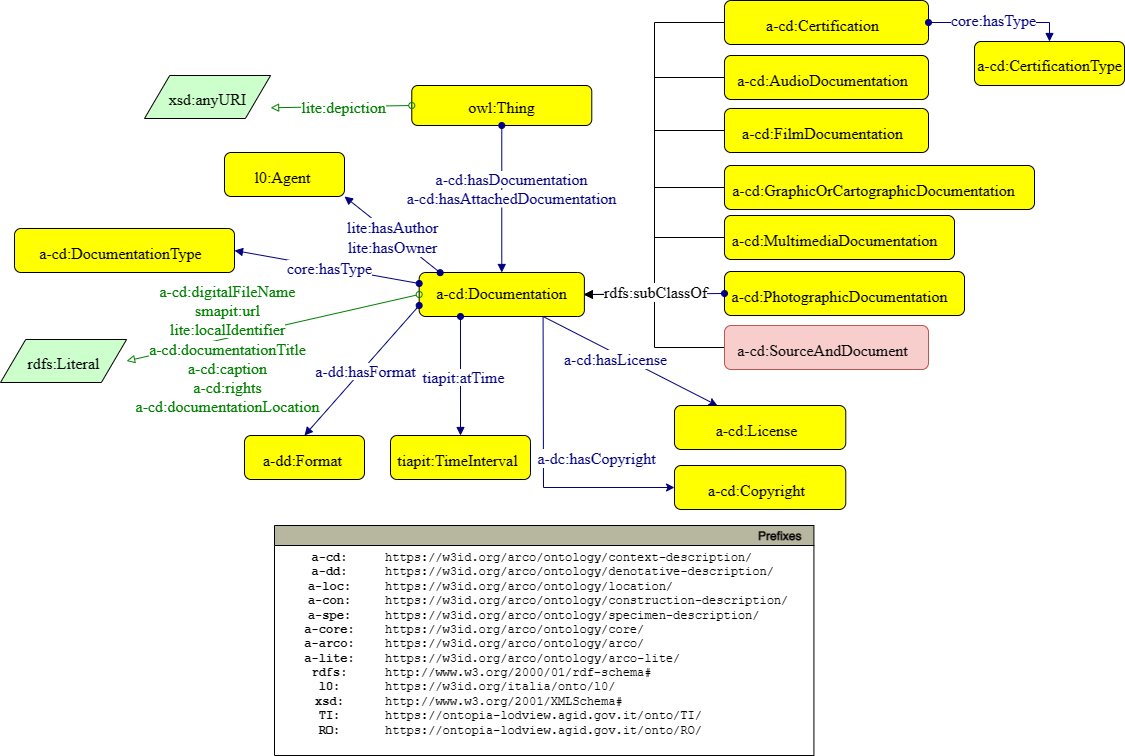
Edition
The pattern represents the edition of a work, characterized by the
publication city, title, publication date, and the publisher's
responsibility.
For additional documentation on the pattern, click
here.
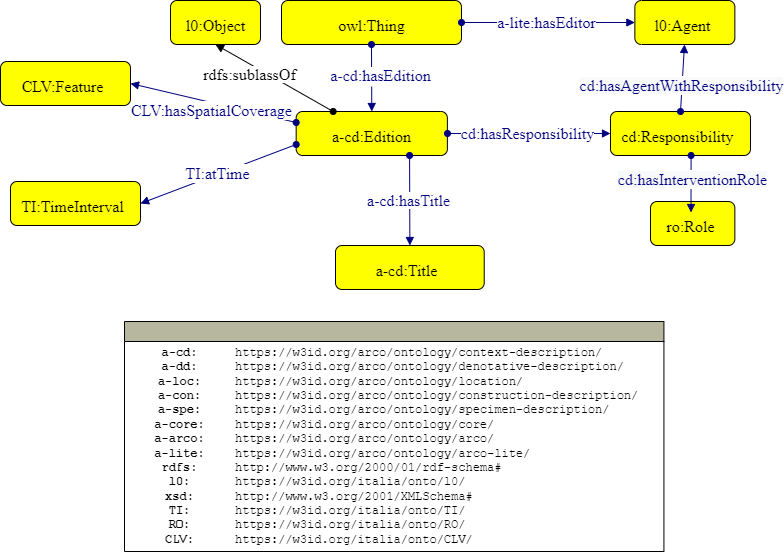
Estimate
The pattern represents the estimated value of a cultural asset,
linking to the economic value of the asset, the appraiser, and the
temporal reference of the appraisal.
For additional documentation on the pattern, click
here.
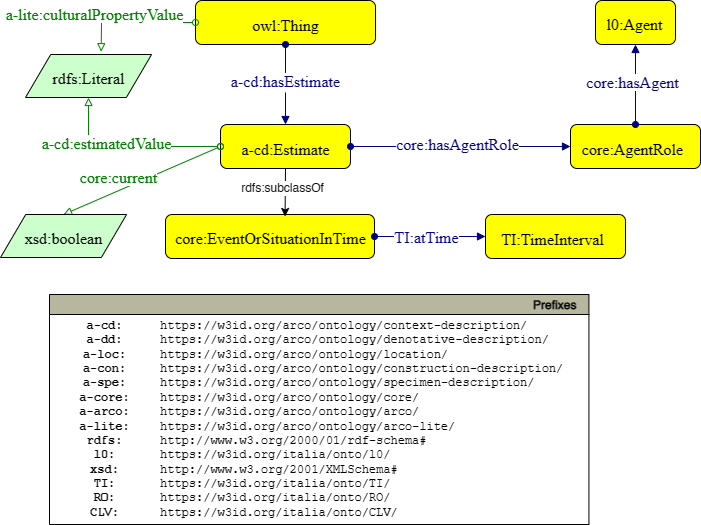
Intervention
The pattern represents an intervention (e.g., conservation)
performed on a cultural asset. It links to all agents involved in
the activity (operator, sponsor, entity issuing the provision,
intervention manager), the temporal reference of when it occurred,
and the type of intervention performed (e.g., restoration, cleaning,
flooring, etc.).
For additional documentation on the pattern, click
here.
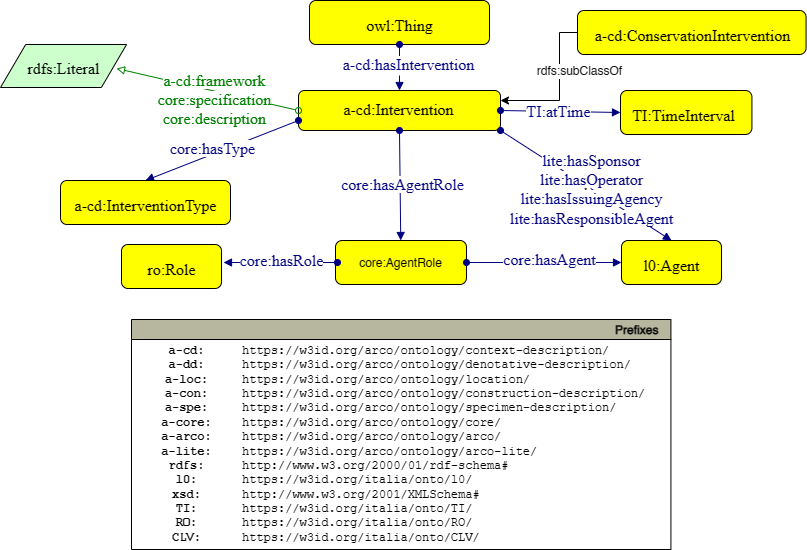
Inventory Situation
The pattern represents the inventory situation of an asset. It is
connected to the inventory number of the object, the inventory
register in which it is located, the agent who assigned the
inventory number, and the asset's heritage category.
For additional documentation on the pattern, click
here.
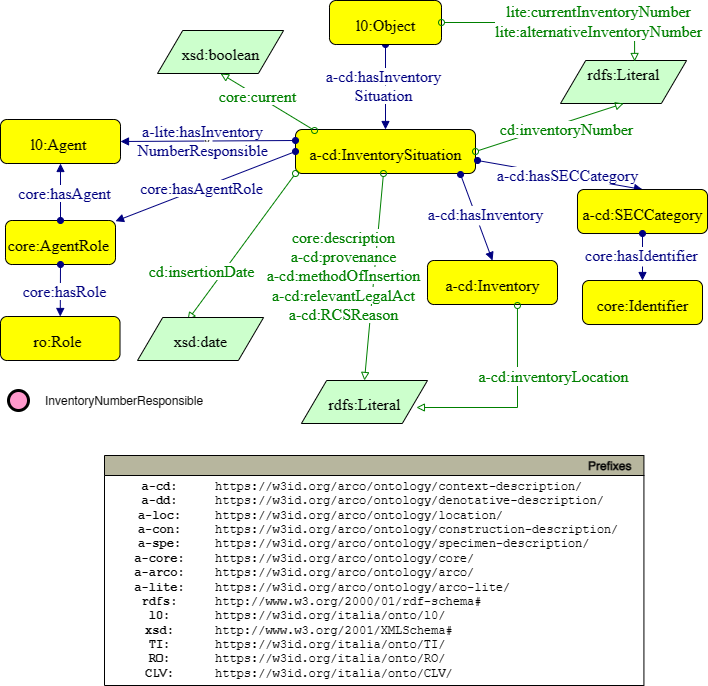
Legal Situation
The pattern represents the legal situation of an asset (e.g.,
ownership). It is linked to the type of legal situation (e.g.,
private ownership, state ownership), the temporal reference, and the
involved agents (e.g., owner, previous possessor, etc.).
For additional documentation on the pattern, click
here.
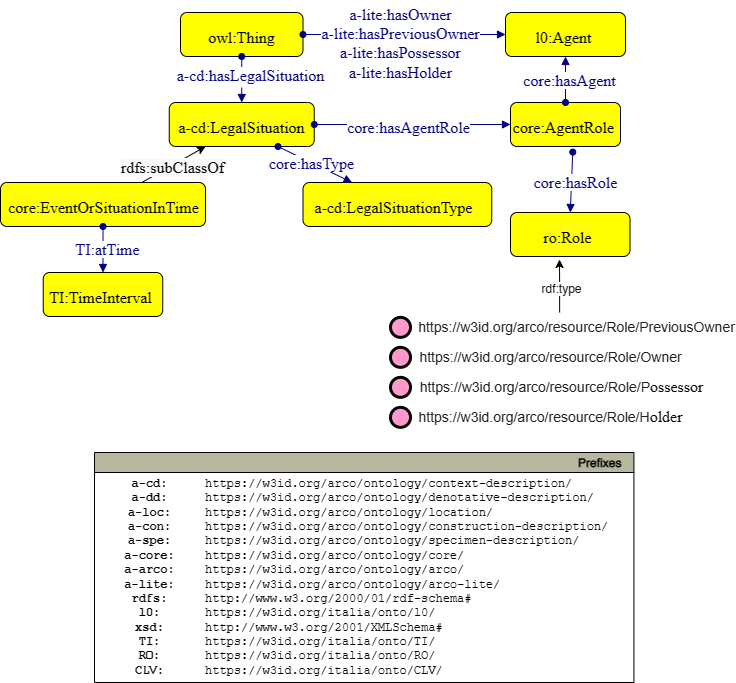
Responsibility
The pattern represents an agent's responsibility for the asset in
question. Responsibility is linked to the agent and their role
(e.g., author, sculptor, collector, etc.). If the agent is not
well-identified, responsibility is connected to the relevant
cultural context.
For additional documentation on the pattern, click
here.
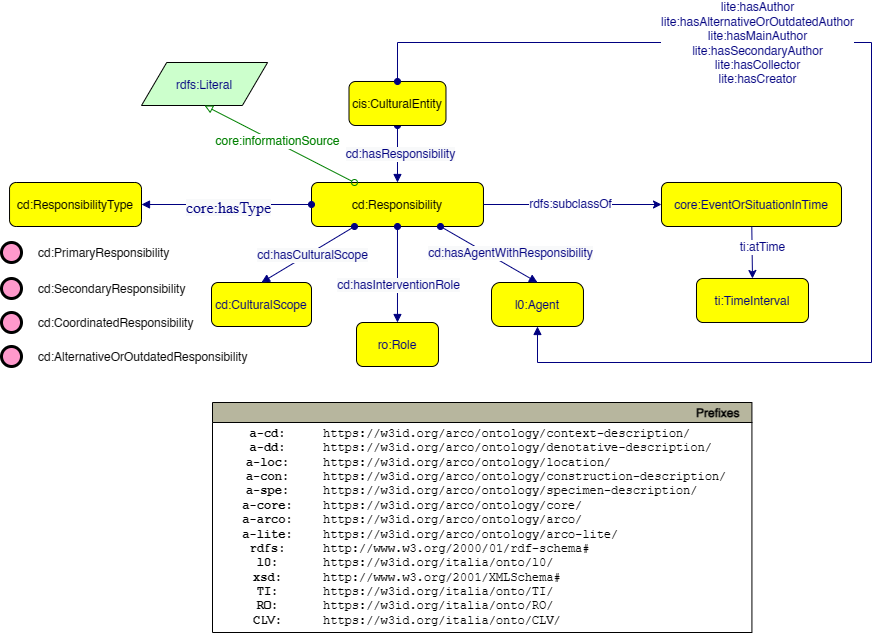
Sex
The pattern represents the biological sex of the described entity,
connected to the entity's sex and the source of information.
For additional documentation on the pattern, click
here.
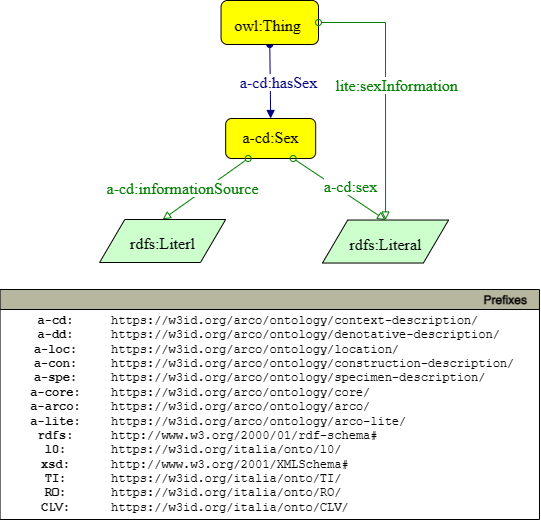
Subject
The pattern represents the subject of the described asset, linked to
the subject's description and classifying concept.
For additional documentation on the pattern, click
here.
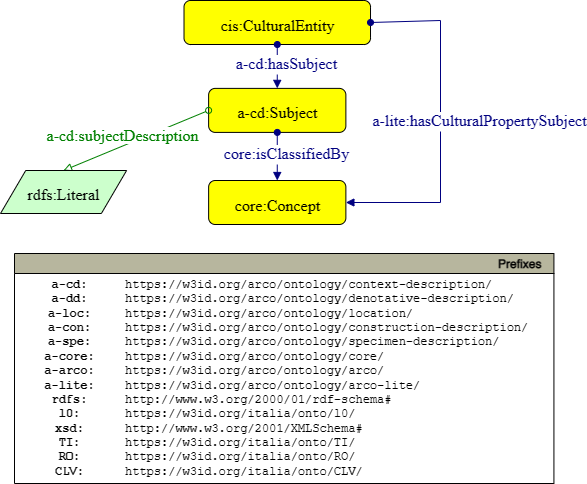
Survey
The pattern represents the investigations that an asset may be
involved in (e.g., archaeological excavations or surveys, laboratory
tests, diagnostic investigations, etc.). The investigation is linked
to the temporal reference of when it was conducted, the method used,
the motivation, the type of investigation (e.g., coring), and the
agents involved in roles such as responsible, operators, scientific
directors, and sponsors of the activity.
For additional documentation on the pattern, click
here.
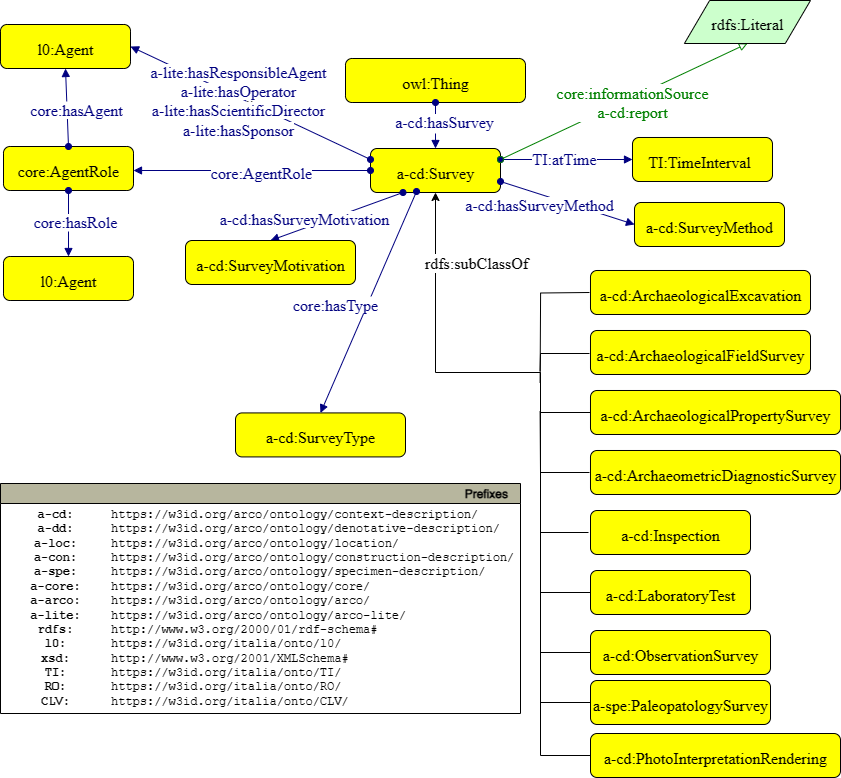
Title
The pattern represents the title of the described entity. It is
linked to the title text, the type (e.g., alternative, original,
secondary, etc.), and the source of information.
For additional documentation on the pattern, click
here.
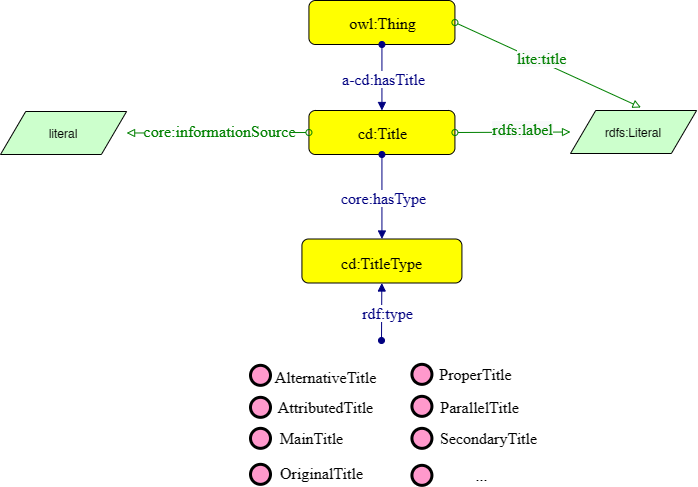
Toponym in Time
The pattern represents the toponym of a place over time, linked to
the toponym text and the temporal reference.
For additional documentation on the pattern, click
here.
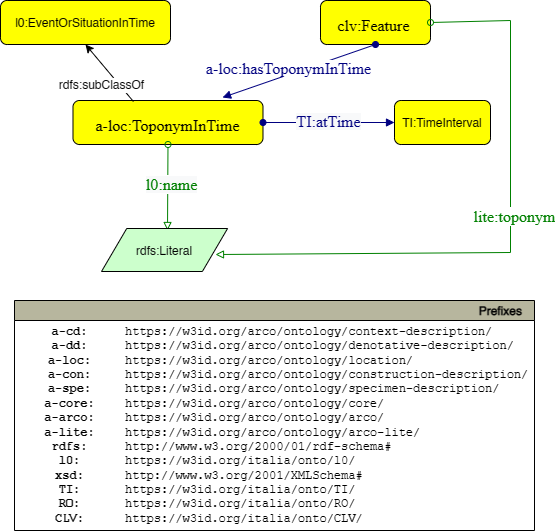
Urban Planning Instrument
The pattern represents the urban and territorial planning instrument
(e.g., zoning plan, landscape plan) affecting an asset. It is
connected to the specific type of instrument in force, the authority
or administrator who issued the provision, and the eligible actions
it describes.
For additional documentation on the pattern, click
here.
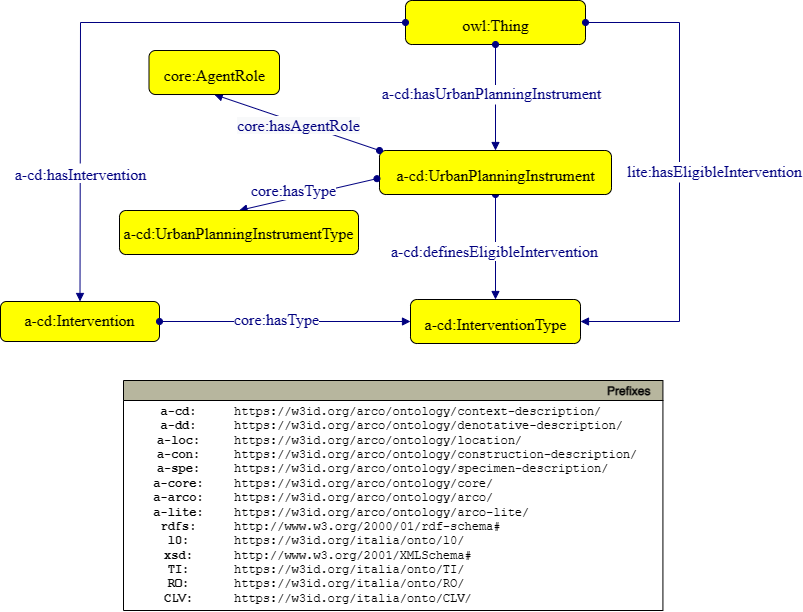
Use
The pattern represents how the asset is used. It is linked to the
type of use (e.g., current, historical, previous), the intended use
(e.g., museum, library, archive), the occasion of use, the location
of use if applicable, and the involved agent.
For additional documentation on the pattern, click
here.
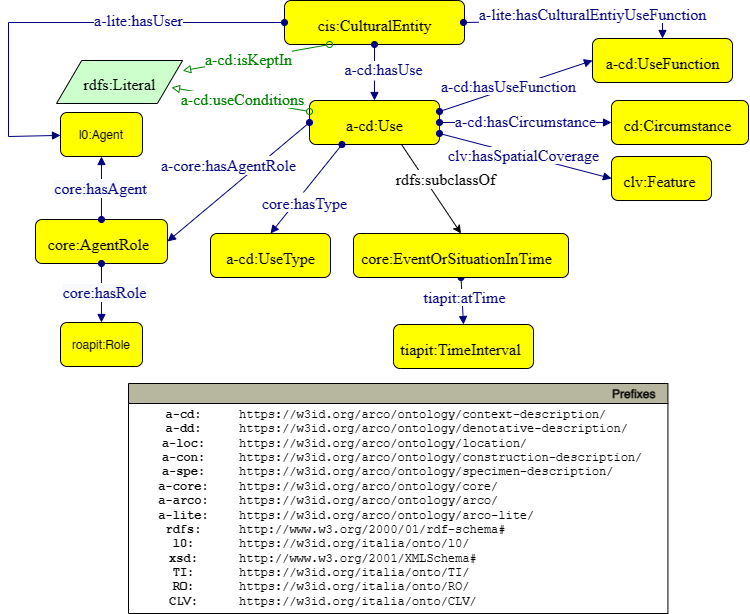
Location Module (a-loc:)
This module describes information related to the location of the
cultural asset.
The following diagrams represent the most representative patterns and
models of the module.
Cadastral Identity
The pattern represents the cadastral identity of an immovable asset
or the physical container of a movable asset. It is linked to the
cadastral data of the immovable, information about the relevant land
registry (the type of land registry and the city), the type of
location, and the temporal interval related to cadastral identity.
For additional documentation on the pattern, click
here.
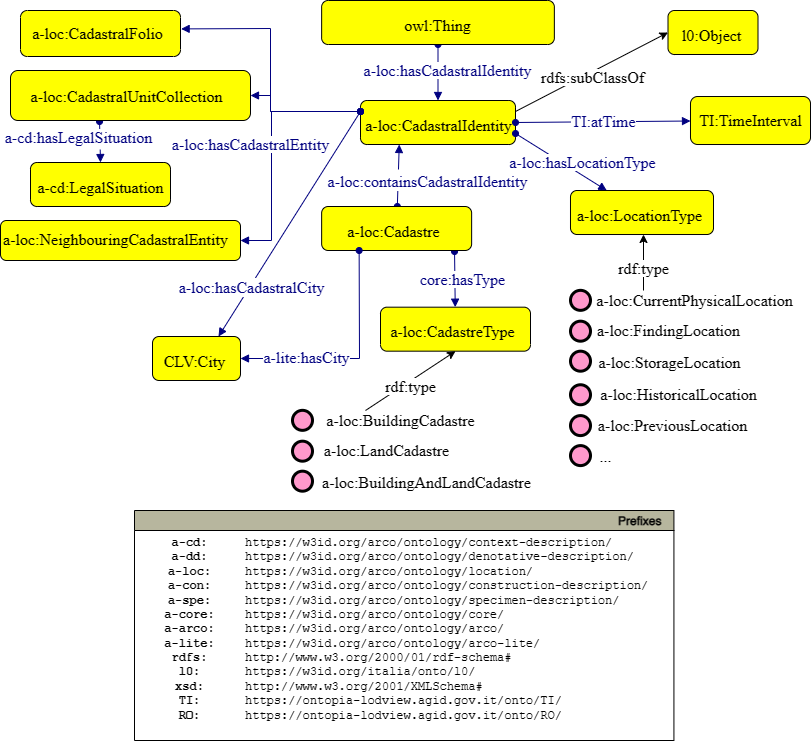
Climate Situation
The pattern represents the climatic situation of the environmental
context in which an asset is located at the time of data
compilation. The climatic situation is therefore linked to an
instance of a-loc:NaturalEnvironment, associating itself with the
temporal period of reference and related measurements (e.g.,
maximum/minimum temperature, precipitation).
For additional documentation on the pattern, click
here.
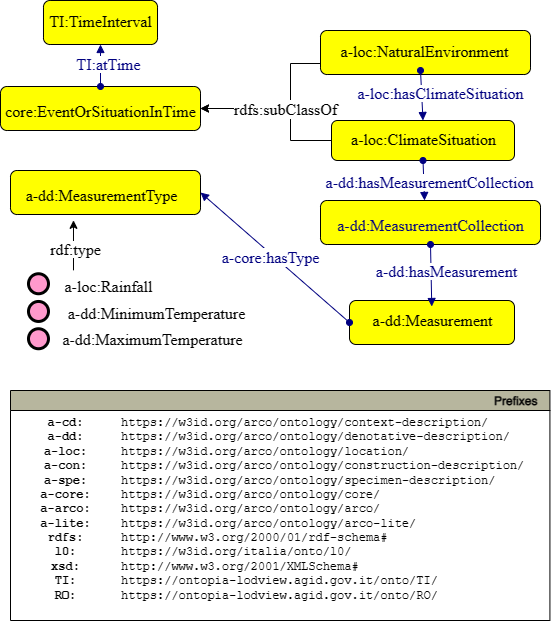
Feature
This modeling structures information related to the location of an
immovable asset or the physical container of a movable asset. The
modeling involves entities from the clvapit ontology, and some parts
of the diagram involve additional patterns such as
a-loc:TimeIndexedTypedLocation and clv:Address. In general, the
clv:Feature linked to the asset/physical container in question via a
loc:TimeIndexedTypedLocation is connected to the georeferencing of
the location (a-loc:Geometry) and the address of the location
(clv:Address), where spatial data such as the country, city,
specific address, etc., are collected.
For additional documentation on the pattern, click
here.
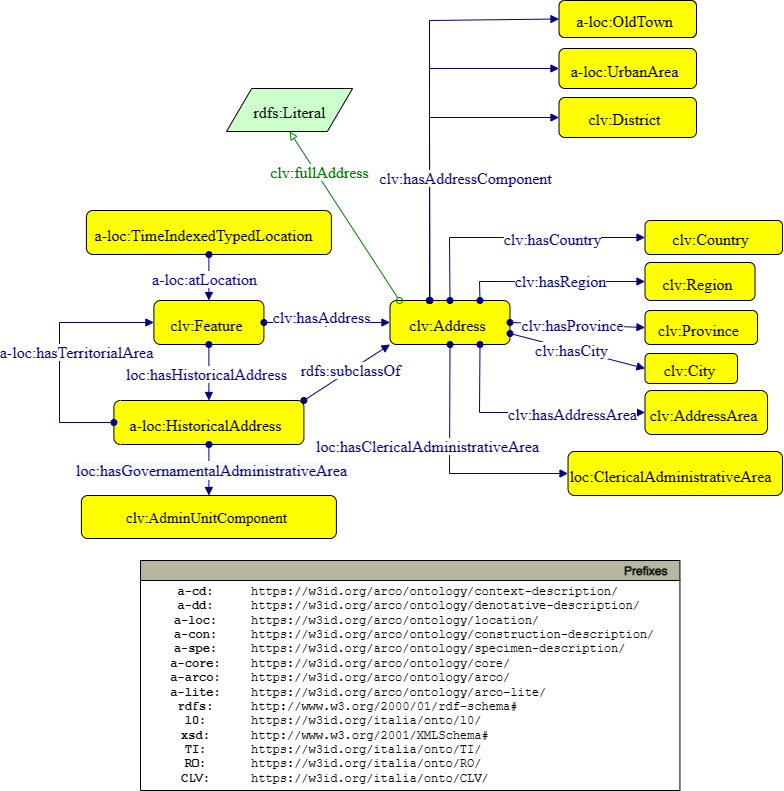
Natural Environment
The pattern represents the natural environment of the location of an
asset. It can be linked to all the physical, geological, climatic,
and other characteristics of an environmental context. For example,
information related to the substrate, soil, temperature
(measurement), depth (measurement), altitude (measurement), etc.
For additional documentation on the pattern, click
here.
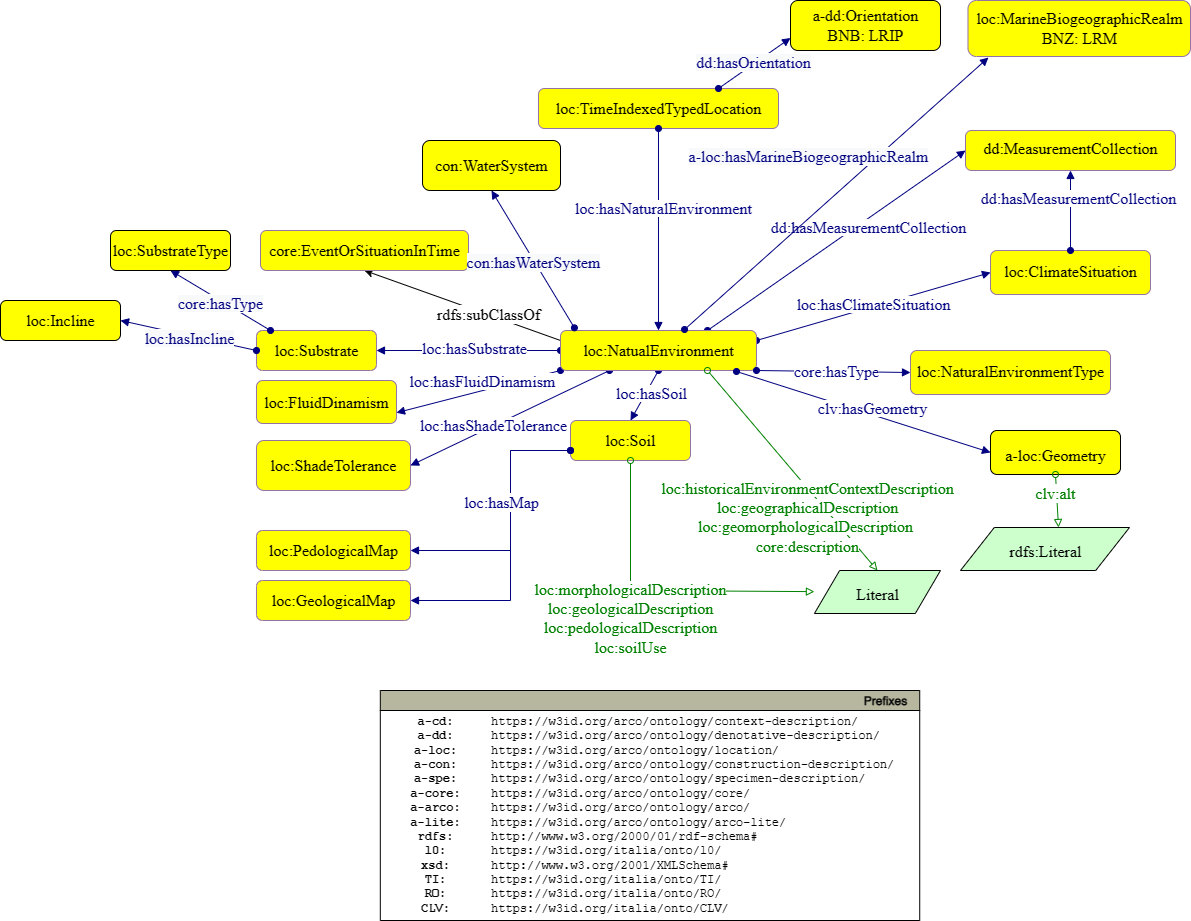
Time Indexed Typed Location
The pattern represents the temporal location of an asset or physical
container. It acts as a link between the asset and information about
the location (clv:Feature), the physical container (cis:Site),
orientation, and the type of location (e.g., discovery, historical,
current, storage, etc.).
For additional documentation on the pattern, click
here.
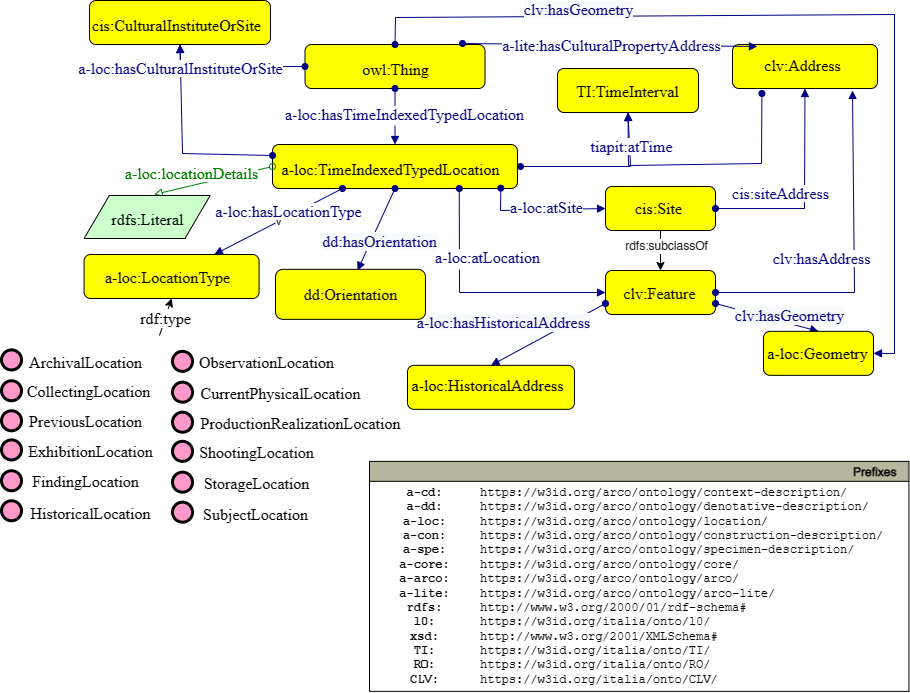
Catalogue Module (a-cat:)
This module models information related to the Catalog of Cultural
Assets and, therefore, catalog sheets.
The following diagrams represent the most representative patterns and
models of the module.
Record
The pattern represents the informative sheet (catalog sheet if
a-cat:CatalogueRecord) of a cultural asset. It is linked to the
cultural asset it describes, the unique identifier, the responsible
agent, various versions, cataloging level, and access profile.
For additional documentation on the pattern, click
here.
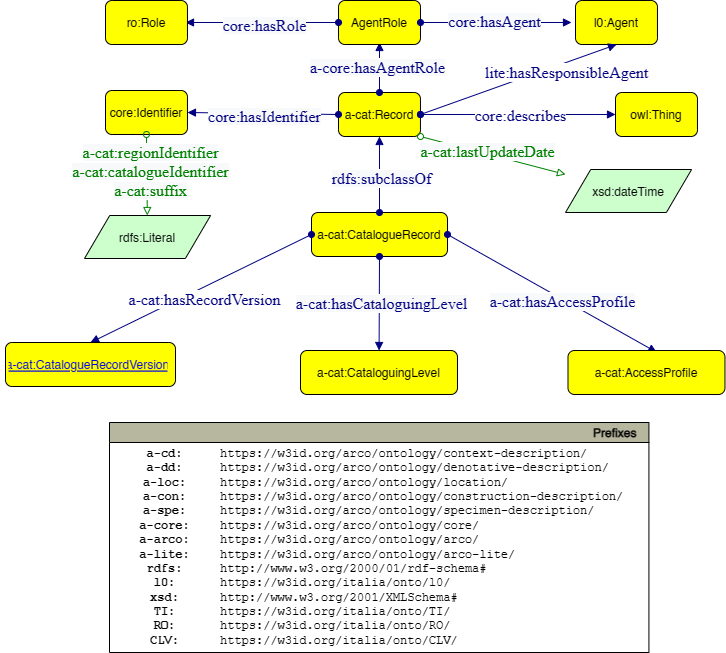
Record Version
The pattern represents a version related to the operations of
drafting, updating, and revising the sheet (catalog sheet if
a-cat:CatalogueRecordVersion). It is connected to the people
involved in the operations (scientific direction, responsible,
operator, etc.), the type of version, and the temporal dimension.
For additional documentation on the pattern, click
here.
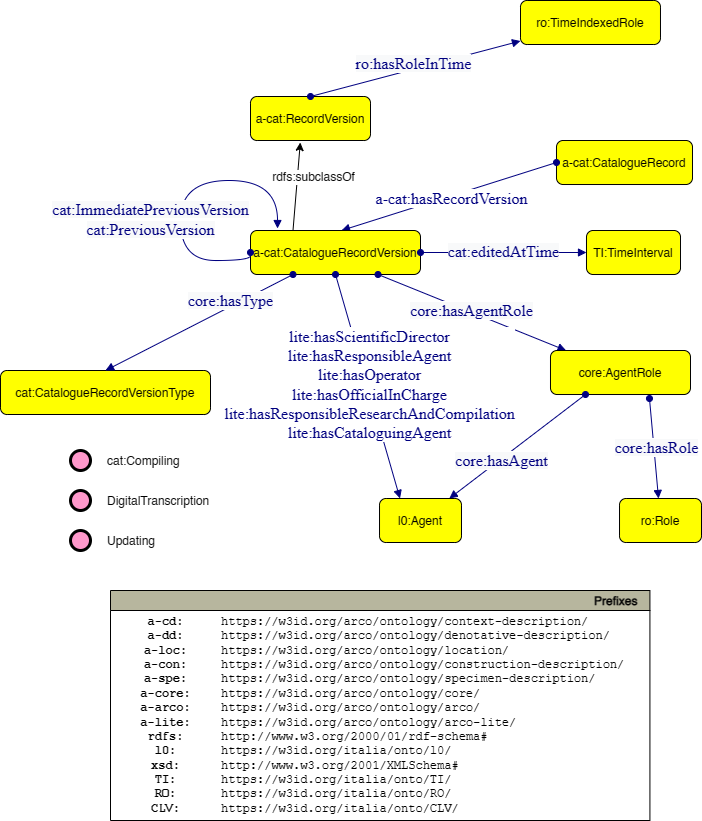
Access Profile
The pattern represents the access profile of a catalog sheet. It
links the catalog sheet with the user, role, access type, and the
temporal reference of the profile's validity. The access profile is
connected to the data dissemination authority, data provider, and an
optional description of the reason for the access profile (e.g.,
research, public access, etc.).
For additional documentation on the pattern, click
here.
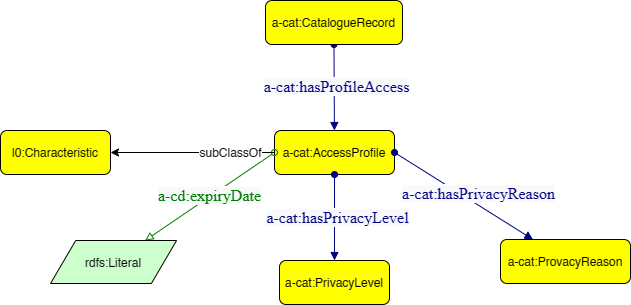
Modulo Cultural Event (a-ce:)
This module is designed to model information pertaining to events
involving cultural assets. The first diagram represents recurrent
events, conceived as collections of events occurring periodically.
Recurrent events can encompass distinct types of immaterial
demo-ethnological cultural assets, such as traditional annual
festivals, as well as events involving other cultural assets. The
second diagram illustrates the reuse and specialization of Cultural-ON
within the context of these events.
RecurrentSituationSeries
This pattern depicts recurrent events, defined as collections of
events organized in a temporal sequence, unified by common factors,
such as theme or location.
Further documentation on this pattern can be found
here.
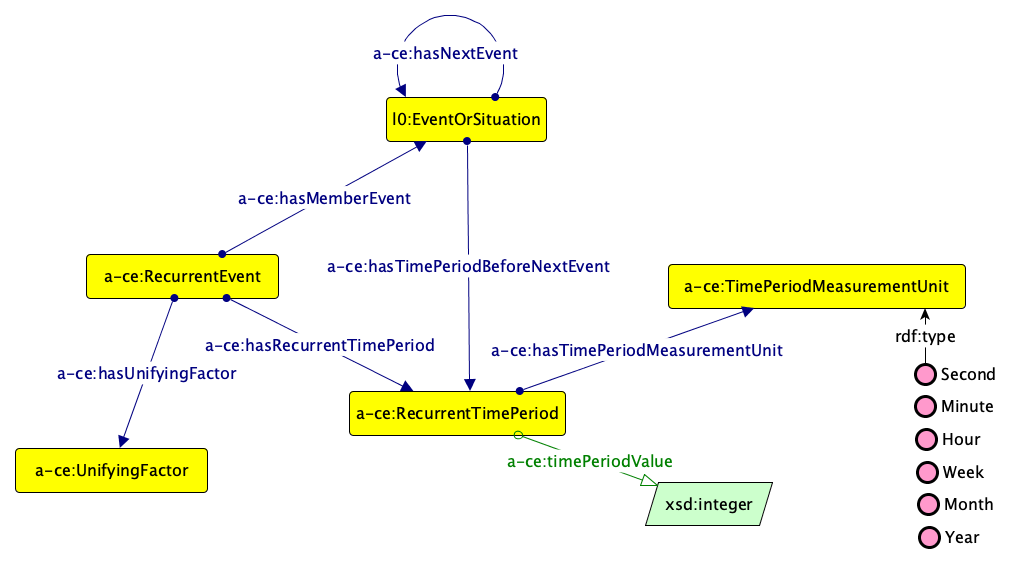
CulturalEvent
The modeling within this pattern represents cultural events that may
involve cultural assets.
Further documentation on this pattern can be found
here.

